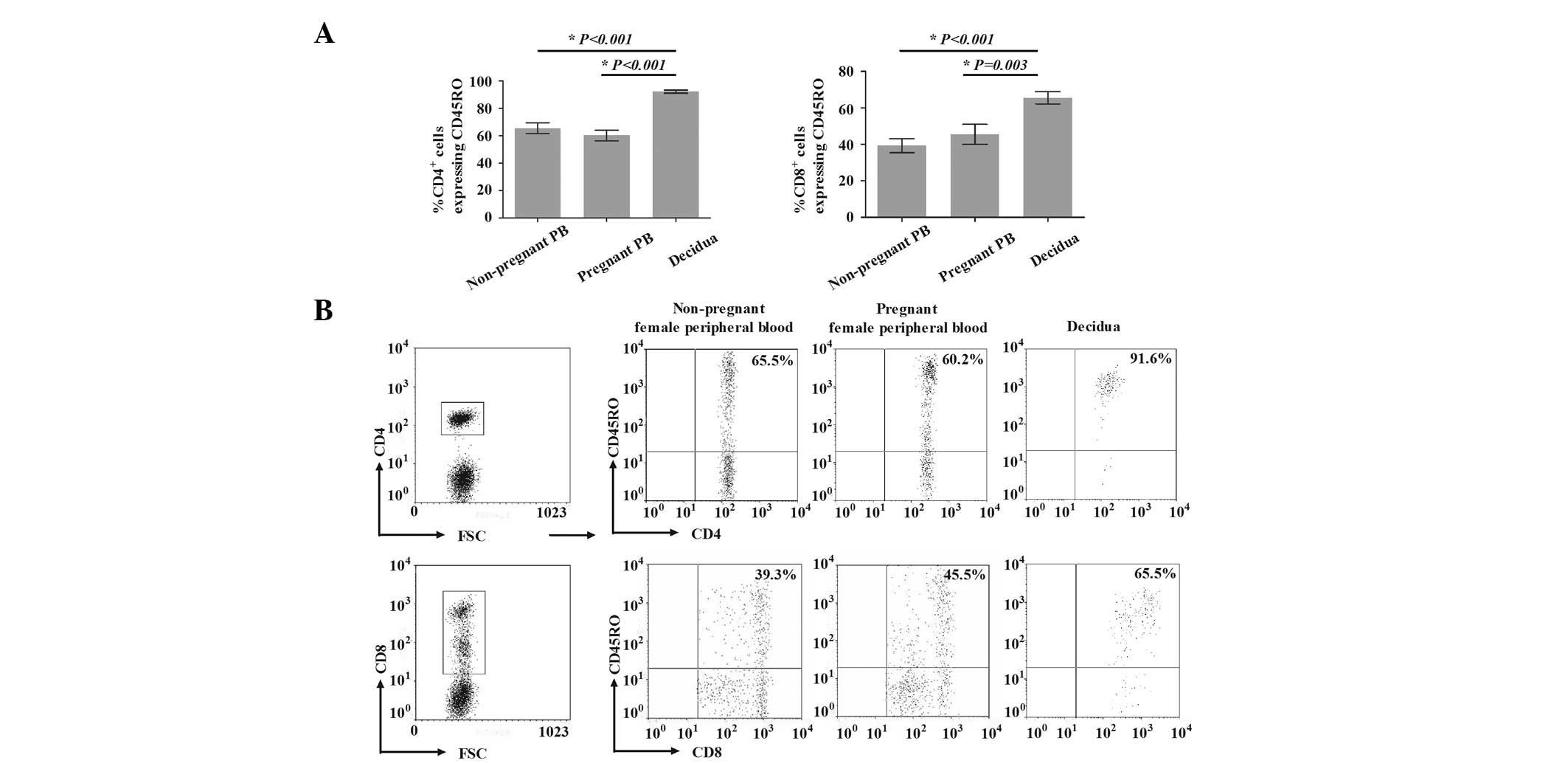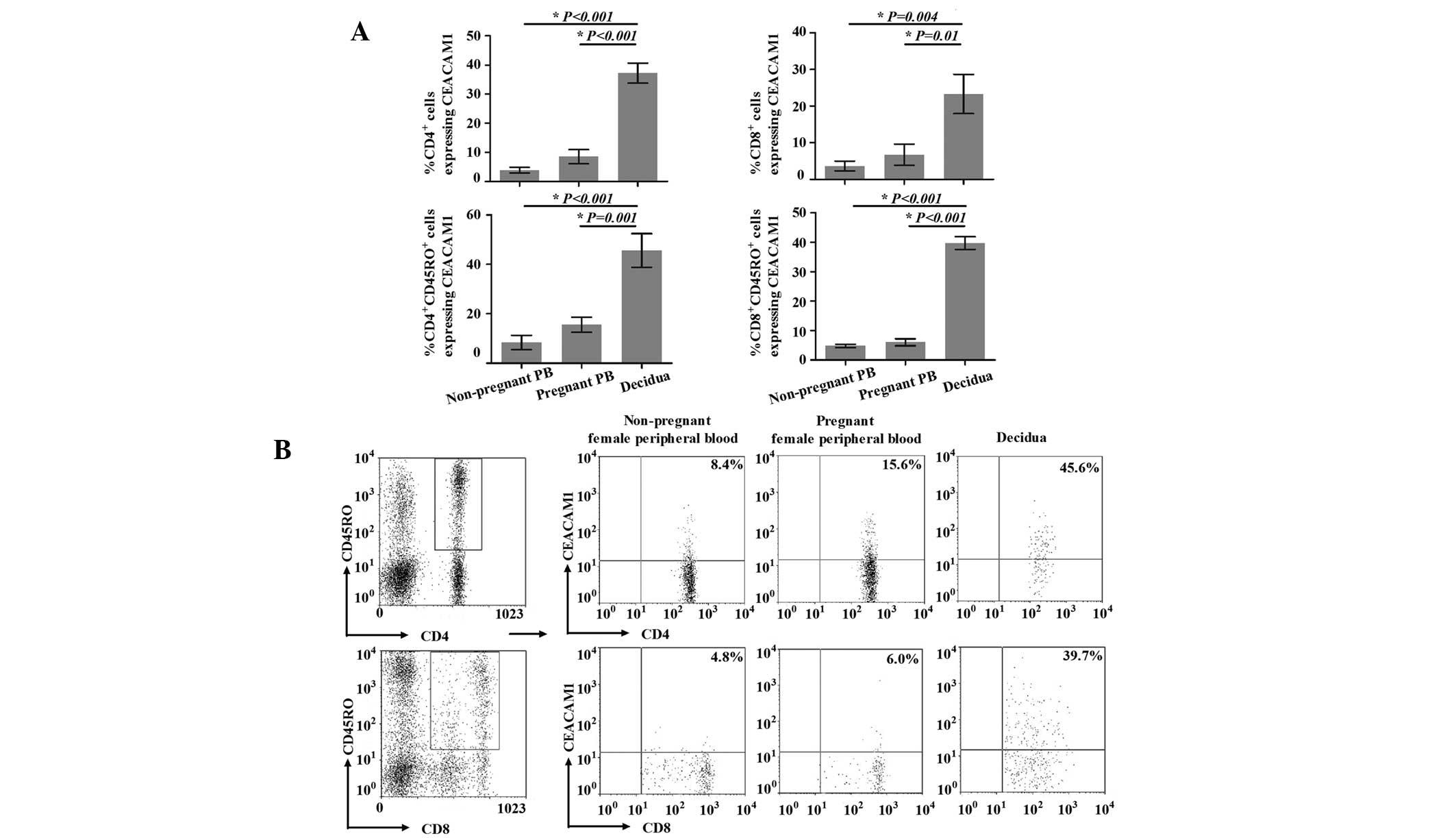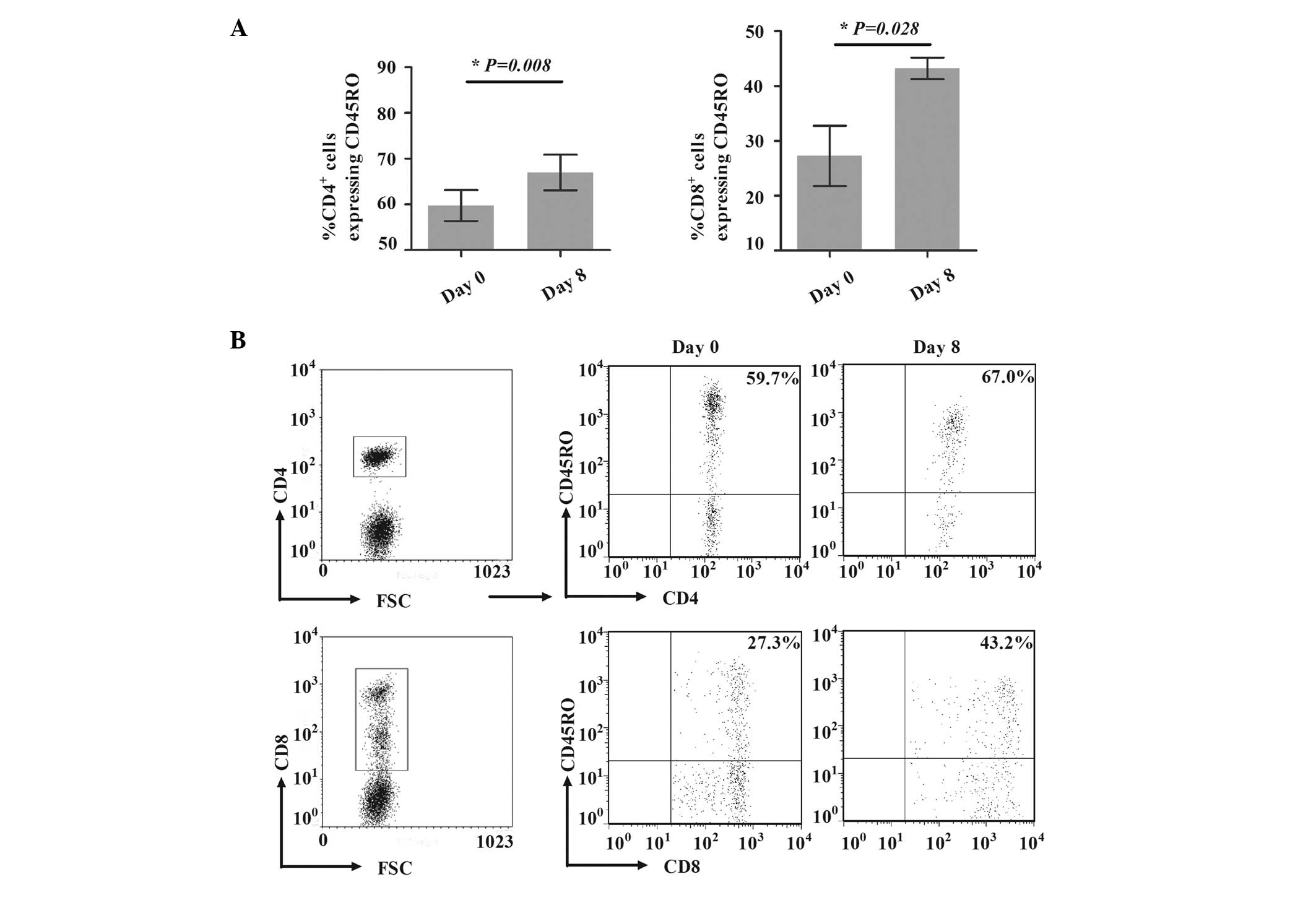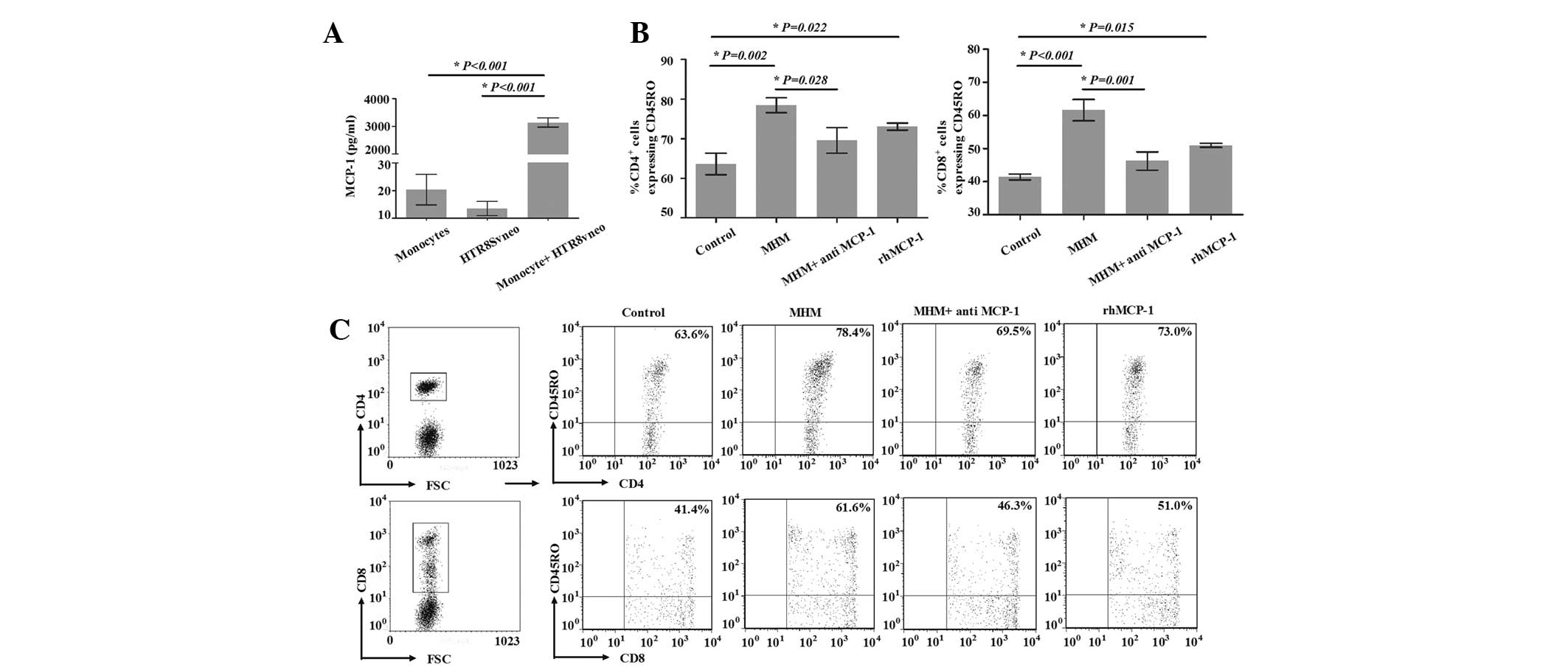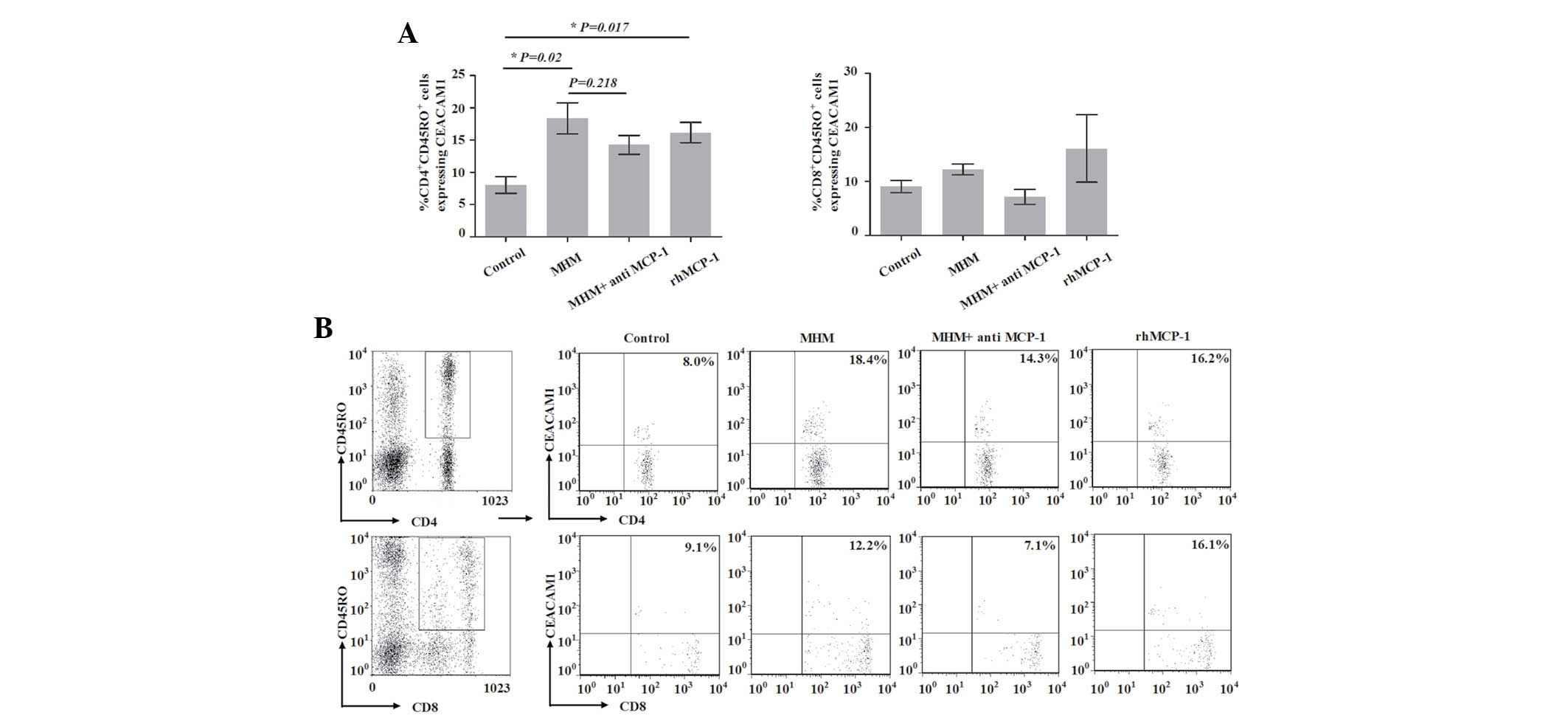Expansion of decidual CD45RO+ T cells with high expression of CEACAM1 in the early stage of pregnancy
- Authors:
- Published online on: June 25, 2013 https://doi.org/10.3892/mmr.2013.1552
- Pages: 571-578
Abstract
Introduction
The establishment of the placenta in humans begins with the invasion and migration of fetal trophoblast cells into the maternal decidua (1). During this process, the decidual environment is infiltrated by a large number of leukocytes, which predominantly include CD56+CD16− NK cells (~70%), macrophages (~10%) and T cells (~10%) (2,3). Previous studies have demonstrated that T cells have an important physiological role in early pregnancy (4). T cells may be subdivided into CD45RA+ T cells and CD45RO+ T cells according to the surface molecules that are expressed. The percentage of CD45RO+ T cells has been demonstrated to increase in first trimester human decidua (5,6). However, the expansion mechanisms of decidual CD45RO+ T cells remain unclear. The expansion of leukocytes in first trimester human decidua may be explained by two mechanisms: i) decidual leukocytes are recruited from the peripheral blood by hormones, cytokines and chemokines (7–10); and ii) the generation of decidual leukocytes occurs in the decidual microenvironment (2,11). Trophoblast cells are primary fetal cells, which are in close contact with maternal immune cells in human decidua (1). Although the effects of trophoblast cells on the recruitment of immune cells have been extensively investigated (8,12,13), the effect of trophoblast cells on the expansion and differentiation of decidual leukocytes remains unknown (14). A previous study demonstrated that the interactions between trophoblast cells and monocytes significantly increased the secretion and production of cytokines and chemokines (15), including monocyte chemoattractant protein-1 (MCP-1), which is important in the generation and survival of CD45RO+ T cells (16). Whether the crosstalk between trophoblast cells and monocytes participates in the expansion of decidual CD45RO+ T cells remains to be elucidated.
Carcinoembryonic antigen-related cell adhesion molecule 1 (CEACAM1), is a multifunctional cellular adhesion molecule, and is a member of the carcinoembryonic antigen family and the immunoglobulin superfamily (17). It is well-established that CEACAM1 is significant in regulating the functions of T cells (18). Numerous studies have demonstrated that CEACAM1 may be expressed at low levels on the surface of resting T cells. However, the expression of CEACAM1 may be rapidly upregulated following T cell activation, implying that CEACAM1 acts as an activation-induced cell surface molecule of T cells (18–21). Previous studies have demonstrated that a fraction of T cells infiltrating the lamina propria of the small intestine in celiac disease and the large intestine in inflammatory bowel disease express CEACAM1. This suggests that CAECAM1 may be expressed at inflammatory sites and participate in modulating the immune response in vivo(21,22). Studies have also indicated that the first trimester of pregnancy is a pro-inflammatory phase (23,24). T cells in first trimester human decidua have been demonstrated to express cell surface activation markers, including CD69 and HLA-DR, which implies that decidual T cells are regionally activated (25). To date, the mechanism of CEACAM1 expression on the surface of decidual T cells at an early stage of pregnancy remains unknown. We therefore investigated the expression of CEACAM1 on the surface of T cells in first trimester human decidua, and the effect of the crosstalk between trophoblast cells and monocytes on the expression of CEACAM1 on the surface of CD45RO+ T cells.
In conclusion, in the present study, we analyzed the percentage of CD45RO+ T cells and the expression of CEACAM1 on the surface of T cells in first trimester human decidua and in the peripheral blood, and identified that these percentages were significantly increased in the decidua. Using the model to generate CD45RO+ T cells in vitro, we demonstrated that conditioned medium from the coculture of the extravillous trophoblast HTR-8/SVneo cell line and monocytes (MHM) increased the percentage of CD45RO+ T cells in an MCP-1 dependent manner, and increased the expression of CEACAM1 on the surface of CD4+CD45RO+ T cells. These data implied that decidual CD45RO+ T cells were activated in an early stage of pregnancy, and suggested that trophoblasts and monocytes may be involved in the increase of CD45RO+ T cells and the high expression of CEACAM1 on their surface.
Materials and methods
Sample collection
Twenty-one healthy nonpregnant females and seventeen healthy pregnant females in their first trimester (from Qilu Hospital, Shandong University, Shandong, China) volunteered to participate in this study (Table I). The use of human tissues was approved by the Ethics Committee of Qilu Hospital (Shandong University, Jinan, China), and written informed consent was obtained from all participants. Peripheral blood samples and decidual tissues were obtained following elective termination of the pregnancy. Cases without maternal or fetal complications were selected for tissue sampling. Peripheral blood samples from nonpregnant females, who were not taking systemic hormonal contraception, were without medical complications and were in the secretory phase of the menstrual cycle, were included as controls. To obtain the decidual mononuclear cells, the decidual tissue was macroscopically separated from the villi, washed twice with phosphate-buffered saline (PBS) to remove the contaminated blood, dissected into small pieces, washed twice again, and then passed through a 120- and 75-μm stainless steel mesh. The decidual mononuclear cells were isolated using Ficoll Histopaque®-1077 (Sigma-Aldrich, St. Louis, MO, USA) by density gradient centrifugation.
Reagents
Fluorescein isothiocyanate (FITC)-conjugated mouse anti-human CD4 monoclonal antibody (mAb) (Jingmei Biological, Co., Beijing, China), CD8 mAb (Becton-Dickinson, Franklin Lakes, NJ, USA), phycoerythrin (PE)-conjugated mouse anti-human CEACAM1 mAb (R&D Systems, Minneapolis, MN, USA), PE-cyanine (Cy) 5-conjugated mouse anti-human CD45RO mAb (Jingmei Biological Co.) and their isotype- and fluorochrome-matched control antibodies, were used for flow cytometry. Human recombinant MCP-1 (rhMCP-1) and monoclonal anti-MCP-1 antibodies were obtained from R&D Systems.
Conditioned medium from the coculture of monocytes and HTR8/SVneo cell line (MHM)
HTR8/SVneo cells were grown in RPMI-1640 medium, supplemented with 10% fetal bovine serum (FBS), 100 U/ml penicillin and 100 mg/ml streptomycin. CD14+ monocytes were isolated from the peripheral blood with a magnetic cell sorting system [CD14+ microbeads (#130-050-201) and an LS column (#130-042-401)] according to the manufacturer’s instructions (Miltenyi Biotech, Bergisch Gladbach, Germany). The HTR8/SVneo cells were cocultured at a ratio of 1:1 (5×105/5×105 cells). The conditioned medium was collected after 40 h.
Enzyme-linked immunosorbent assay (ELISA)
The MCP-1 levels in the culture supernatant were measured with the Human CCL2/MCP-1 Quantikine ELISA kit (R&D Systems), and assays were conducted according to the manufacturer’s instructions. All measurements were performed in triplicate to avoid technical error and intra-assay variants.
Flow cytometric analysis
The expression of CD4, CD8, CD45RO and CEACAM1 on the surface of T cells was determined by extracellular staining with a specific monoclonal antibody. The background fluorescence was assessed using the appropriate isotype-and fluorochrome-matched control mAbs. The FACSCalibur flow cytometer and the CellQuest software program of the FACSCalibur system (Becton-Dickinson) were used for the measurement and analysis of the stained cells.
Model to generate CD45RO+ T cells
Peripheral blood mononuclear cells (PBMCs) were isolated from the peripheral blood of healthy donors using gradient centrifugation over Histopaque®-1077 (Sigma-Aldrich). PBMCs from one donor were treated with 25 mg/ml mitomycin C (Roche, Basel, Switzerland) for 20 min, and washed twice with warmed RPMI-1640 supplemented with 10% FBS. PBMCs were reseeded into 24-well plates at a density of 500 μl/well and a concentration of 1×106 cells. PBMCs from another donor, without treatment, were cocultured with the pretreated PBMCs, (density, 500 μl/well; concentration, 1×106 cells). The supernatant and control medium pretreated with anti-MCP-1 mAb (10 μg/ml) or rhMCP-1 (5 μg/ml) for 30 min were added to the 24-well plates (density, 1 ml/well). A mixed lymphocyte reaction (MLR) was conducted for 8 days, cells were collected, and the medium was changed every 3 days.
Statistical analysis
Statistical analysis was performed using SPSS version 11.5. Normality of the data was tested using the Shapiro-Wilk test. Data were normally distributed, and the results are presented as the mean ± standard deviation (SD). A one-way analysis of variance (ANOVA) test was used for statistical comparisons between groups (where number of groups ≥3) and a Fisher’s least significant difference test was used for post hoc analysis of the significant ANOVA results. A paired student’s t-test was used for the statistical analysis of the differences in the percentages of CD45RO+ T cells in the model, in vitro, on days 0 and 8. P<0.05 was considered to indicate a statistically significant difference.
Results
Percentage of CD45RO+ T cells in first trimester human decidua
The percentages of CD45RO+ T cells in first trimester human decidua and in the peripheral blood of healthy nonpregnant and pregnant females are presented in Fig. 1. For healthy nonpregnant and pregnant females, the percentages of CD4+CD45RO+ T cells among CD4+ T cells in the peripheral blood were 65.5±12.6 and 60.2±12.3%, respectively. The percentage of CD4+CD45RO+ T cells among CD4+ T cells in the decidua was significantly higher (91.6±4.8%) compared with that in the peripheral blood from nonpregnant (P<0.001) and pregnant (P<0.001) females. Similarly, the percentage of CD8+CD45RO+ T cells among CD8+ T cells in the decidua (65.5±10.7%) was also significantly higher, compared with that in the peripheral blood of nonpregnant (39.3±12.2%) and pregnant (45.5±17.2%) females (P<0.001 and P=0.003, respectively). However, the percentages of CD4+CD45RO+ T cells among CD4+ and CD8+CD45RO+ T cells among CD8+ T cells in the peripheral blood were not significantly different between nonpregnant and pregnant females (P=0.265 and P=0.317, respectively).
Expression of CEACAM1 on the surface of peripheral and decidual T cells
A number of studies have demonstrated that CEACAM1, an activation-induced cell surface molecule of T cells, inhibits the cytokine production, proliferation and cytotoxic activity of activated T cells by homophilic (CEACAM1-CEACAM1) and heterophilic (CEACAM1-CEACAM5 and CEACAM1-Opa) interactions (26–29). As numerous studies have demonstrated that decidual T cells are regionally activated (25,30,31), we detected the expression of CEACAM1 on the surface of decidual T cells. As shown in Fig. 2A, for healthy nonpregnant and pregnant females, the percentages of CD4+CEACAM1+ T cells in the peripheral blood (3.9±2.7 and 8.5±6.8%, respectively) were not significantly different (P=0.204). However, the percentage of CD4+CEACAM1+ T cells in the decidua (37.2±9.8%) was significantly higher compared with that in the peripheral blood (P<0.001 vs. peripheral blood from nonpregnant females and P<0.001 vs. peripheral blood from pregnant females). The percentages of CD8+CEACAM1+ T cells showed the same trends as those of the CD4+CEACAM1+ T cells, and those in the peripheral blood of nonpregnant and pregnant females, and in the decidua were 3.6±2.6, 6.7±5.8 and 23.3±10.7%, respectively (P=0.004, peripheral blood from nonpregnant females vs. decidua; P=0.01, peripheral blood from pregnant females vs. decidua; P=0.56, peripheral blood from nonpregnant females vs. pregnant females).
Further, we identified the expression of CEACAM1 on the surface of decidual and peripheral CD45RO+ T cells (Fig. 2). The expression of CEACAM1 on the surface of peripheral CD4+CD45RO+T cells from healthy nonpregnant females was identified in 8.4±7.1% of cells, in contrast to 15.6±7.4% of such cells from healthy pregnant females; however, this difference was not significant (P=0.436). Notably, CEACAM1-expressing cells were present at a significantly higher level (45.6±21.4%) in the decidua compared with the peripheral blood from nonpregnant (P<0.001) and pregnant (P=0.001) females. The expression of CEACAM1 on the surface of decidual and peripheral CD8+CD45RO+ T cells demonstrated the same trends, with expression rates of 4.8±1.0 and 6.0±2.0% in healthy nonpregnant and pregnant females, respectively (P=0.586, peripheral blood from nonpregnant females vs. pregnant females). In addition, the expression of CEACAM1 on the surface of decidual CD8+CD45RO+ T cells (39.7±3.8%) was significantly higher than that in the peripheral blood (P<0.001 vs. peripheral blood from nonpregnant females and P<0.001 vs. peripheral blood from pregnant females).
Expansion of CD45RO+ T cells by MHM is MCP-1 dependent
To investigate the potential expansion mechanisms of CD45RO+ T cells, the model to generate CD45RO+ T cells was established in vitro, as described in Materials and methods. Compared with the percentages on day 1, the percentages of CD4+CD45RO+ T cells among CD4+ T cells and of CD8+CD45RO+ T cells among CD8+ T cells were significantly increased on day 8, from 59.7±6.8 to 67.0±7.7% (P=0.008) and from 27.3±11.1 to 43.2±3.9% (P=0.028; Fig. 3), respectively, indicating that the induced model was successful.
To clarify the effect of the interaction between trophoblast cells and monocytes on the expansion of CD45RO+ T cells, MHM was added to the model, and the percentage of CD4+CD45RO+ T cells among CD4+ T cells on day 8 was significantly increased from 63.6±4.7 to 78.4±3.2% (P=0.002). Similarly, the percentage of CD8+CD45RO+ T cells among CD8+ T cells on day 8 was increased from 41.4±1.6 to 61.6±5.6% (P<0.001; Fig. 4B and C). These data suggested that trophoblasts and monocytes were likely to be involved in the generation of CD45RO+ T cells. The secretion of MCP-1 was determined by ELISA, as it has been demonstrated to be significant in the generation of CD45RO+ T cells (16). Consistent with a previous study (15), we observed that the production of MCP-1 in the MHM was notably higher than that in the monocyte or human trophoblast HTR8/SVneo cell line cultures (Fig. 4A). In order to clarify the effect of MCP-1 from the MHM on the increase of CD45RO+ cells in the model, neutralizing antibody against MCP-1 was added to the MHM; the percentage of CD4+CD45RO+ T cells among CD4+ T cells on day 8 was significantly decreased in the MHM + anti-MCP-1 group compared with that in the MHM group (69.5±5.6 vs. 78.4±3.2, P=0.028; Fig. 4B and C). Compared with the control group, the percentage of CD4+CD45RO+ T cells among CD4+ T cells on day 8 was significantly increased in the rhMCP-1 group (63.6±4.7 vs. 73.0±1.5, respectively, P=0.022). The percentage of CD8+CD45RO+ T cells among CD8+ T cells in the MHM + anti-MCP-1 group was significantly decreased compared with that of the MHM group (46.3±4.8 vs. 61.6±5.6%, P=0.001; Fig. 4B and C). Compared with the control group, the percentage of CD8+CD45RO+ T cells among CD8+ T cells on day 8 was significantly increased in the rhMCP-1 group (41.4±1.6 vs. 51.0±1.0%, P=0.015). These results suggested that MCP-1 was involved in the increase of CD45RO+ T cells through the addition of MHM.
Proportion of CEACAM1-expressing CD4+CD45RO+ T cells is increased by MHM and rhMCP-1
To investigate the potential involvement of the interaction of trophoblast cells and monocytes in the expression of CEACAM1 on the surface of CD45RO+ T cells in first trimester human decidua, we analyzed the expression of CEACAM1 on the surface of such T cells in the model. As shown in Fig. 5, the proportion of CEACAM1-expressing CD4+CD45RO+ T cells in the control group on day 8 was 8.04±1.31% (Fig. 5). However, when cells in the model were treated with MHM, the proportion of CEACAM1-expressing CD4+CD45RO+ T cells on day 8 was significantly increased (18.38±2.4%) compared with that of the control group (P=0.02). Compared with the MHM group, the proportion of CEACAM1-expressing CD4+CD45RO+ T cells was not significantly decreased in the MHM + anti-MCP-1 group (P=0.218); however, that proportion was significantly increased in the rhMCP-1 group compared with that in the control group (P=0.017). These results implied that MCP-1 was involved in the increase in the proportion of CEACAM1-expressing CD4+CD45RO+ T cells induced by MHM. The proportion of CEACAM1-expressing CD8+CD45RO+ T cells did not exhibit a statistically significant difference among the four groups (P=0.303). These data implied that the proportion of CEACAM1-expressing CD4+CD45RO+ T cells increased with the expansion of CD4+CD45RO+ T cells, and that the interaction of trophoblast cells and monocytes may be involved in the process.
Discussion
In the present study, we demonstrated that the percentages of CD45RO+ T cells were significantly higher in first trimester human decidua than in the peripheral blood, which is concordant with previous studies (5,6).
A number of studies have indicated that T cells in first trimester human decidua are regionally activated (5,30,31). As CEACAM1 has been demonstrated to be important in modulating the functions of T cells and is regarded as an activation-induced cell surface molecule of T cells (20,32), we measured the expression of CEACAM1 on the surface of T cells in an early stage of pregnancy. Notably, we identified CEACAM1-expressing cells in significantly higher numbers among freshly isolated CD4+ and CD8+ T cells in first trimester human decidua than in the peripheral blood. The data also suggested that these decidual T cells were activated. We analyzed the expression of CEACAM1 on the surface of CD45RO+ T cell subsets and identified the proportion of cells expressing CEACAM1 among CD4+CD45RO+ and CD8+CD45RO+ T cells to be significantly higher in first trimester human decidua than in the peripheral blood. These data implied that a high percentage of decidual CD45RO+ T cells were in an active state, and that CEACAM1 may participate in the regulation of the activation and functions of the decidual CD45RO+ T cells. In further experiments, we determined which factors induce the increase in the percentage of CD45RO+ T cells, and in the percentage of CD45RO+ T cells expressing CEACAM1, in first trimester human decidua.
Previous studies have demonstrated that during the invasion and migration of fetal trophoblast cells into the maternal decidua, the two come into close contact with maternal leukocytes (1). Previous studies have focused on the recruitment of leukocytes by trophoblast cells (8,12,13), and limited data are available on the ability of trophoblast cells to modulate the expansion and activation of decidual T cells (14). It has been demonstrated that the interaction of trophoblast cells and monocytes markedly enhances the expression of cytokines/chemokines, including MCP-1 (15). MCP-1, the main monocyte chemoattractant, has been demonstrated to be associated with the generation and survival of CD45RO+ T cells (16). In the present study, to investigate the possible expansion and activation mechanisms of decidual CD45RO+ T cells, we developed an effective in vitro model to generate these cells. We identified that CD45RO+ T cells were greatly expanded when the model was supplemented with MHM, suggesting that the direct interaction between trophoblast cells and monocytes may contribute to the increase in CD45RO+ T cells in first trimester human decidua. Further studies are required to determine whether this increase in CD45RO+ T cells is a result of the proliferation of inherent memory T cells in vitro, or the conversion from naïve T cells (or other subsets). Our results also demonstrated that the increase in CD45RO+ T cells was dependent on the increased expression of MCP-1 in the MHM.
In addition, we demonstrated that in the induced model used to generate CD45RO+ T cells, as the percentage of CD45RO+ T cells increased, the expression of CEACAM1-expressing CD4+CD45RO+ T cells also increased (from 8.0±1.3 to 18.4±2.4%). Notably, we identified that the number of CEACAM1-expressing CD4+CD45RO+ T cells significantly increased when the model was supplemented with MHM; however, the expression of CEACAM1-expressing CD8+CD45RO+ T cells did not show a statistically significant difference between the groups. These data further implied that the soluble immune mediators resulting from the direct interaction between trophoblast cells and monocytes may contribute to the increase in the expression of CEACAM1 on the surface of CD4+CD45RO+ T cells, but not on that of CD8+CD45RO+ T cells, in first trimester human decidua. CEACAM1 has been detected on the surface of extravillous trophoblast cells, and is hypothesized to promote the invasion of these cells (33–35). In addition, numerous studies have demonstrated that CEACAM1 inhibits the cytokine production, proliferation and cytotoxic activity of activated T cells, by homophilic and heterophilic interactions (26–29). The effect of the homophilic interaction of CEACAM1 on the surface of decidual T cells and extravillous trophoblast cells in the induction of maternal-fetal tolerance remains to be elucidated.
In conclusion, our data indicated that during the invasion and migration of fetal trophoblast cells into the maternal decidua, the soluble immune mediators that are secreted as a result of the interaction between trophoblasts and monocytes may be involved in the increase of decidual CD45RO+ T cells and the expression of CEACAM1 on their surfaces. Our results provide insights into the interaction between maternal immune cells and fetal antigens.
Acknowledgements
The authors wish to acknowledge Dr Mumtaz Virji (University of Bristol, UK) and Dr Markus Neckenig (University of Sheffield, UK) for their critiques of the manuscript. The authors would like to thank Dr Charles H. Graham (Department of Anatomy and Cell Biology, Queen’s University, Kingston, ON Canada) for providing the HTR8/SVneo cell line and Ms. Zhen Li for support with the statistical analysis (Shandong Academy of Medical Sciences, Shandong, China). This study was supported by grants from the National Natural Science Foundation of China (grant nos. 30872321, 81072406 and 31100650), the Natural Science Foundation of Shandong Province (grant no. Y2008C02) and the Independent Innovation Foundation of Shandong University (grant no. 2012TS143).
References
|
Burrows TD, King A and Loke YW: Trophoblast migration during human placental implantation. Hum Reprod Update. 2:307–321. 1996. View Article : Google Scholar : PubMed/NCBI | |
|
King A, Gardner L and Loke YW: Co-stimulation of human decidual natural killer cells by interleukin-2 and stromal cells. Hum Reprod. 14:656–663. 1999. View Article : Google Scholar : PubMed/NCBI | |
|
Sindram-Trujillo A, Scherjon S, Kanhai H, Roelen D and Claas F: Increased T-cell activation in decidua parietalis compared to decidua basalis in uncomplicated human term pregnancy. Am J Reprod Immunol. 49:261–268. 2003. View Article : Google Scholar : PubMed/NCBI | |
|
Trundley A and Moffett A: Human uterine leukocytes and pregnancy. Tissue Antigens. 63:1–12. 2004. View Article : Google Scholar : PubMed/NCBI | |
|
Saito S, Nishikawa K, Morii T, et al: A study of CD45RO, CD45RA and CD29 antigen expression on human decidual T cells in an early stage of pregnancy. Immunol Lett. 40:193–197. 1994. View Article : Google Scholar : PubMed/NCBI | |
|
Slukvin II, Merkulova AA, Vodyanik MA and Chernyshov VP: Differential expression of CD45RA and CD45RO molecules on human decidual and peripheral blood lymphocytes at early stage of pregnancy. Am J Reprod Immunol. 35:16–22. 1996.PubMed/NCBI | |
|
Schumacher A, Brachwitz N, Sohr S, et al: Human chorionic gonadotropin attracts regulatory T cells into the fetal-maternal interface during early human pregnancy. J Immunol. 182:5488–5497. 2009. View Article : Google Scholar | |
|
Tsuda H, Michimata T, Hayakawa S, et al: A Th2 chemokine, TARC, produced by trophoblasts and endometrial gland cells, regulates the infiltration of CCR4+ T lymphocytes into human decidua at early pregnancy. Am J Reprod Immunol. 48:1–8. 2002. View Article : Google Scholar : PubMed/NCBI | |
|
Carlino C, Stabile H, Morrone S, et al: Recruitment of circulating NK cells through decidual tissues: a possible mechanism controlling NK cell accumulation in the uterus during early pregnancy. Blood. 111:3108–3115. 2008. View Article : Google Scholar : PubMed/NCBI | |
|
Qu X, Yang M, Zhang W, et al: Osteopontin expression in human decidua is associated with decidual natural killer cells recruitment and regulated by progesterone. In Vivo. 22:55–61. 2008.PubMed/NCBI | |
|
Vacca P, Cantoni C, Vitale M, et al: Crosstalk between decidual NK and CD14+ myelomonocytic cells results in induction of Tregs and immunosuppression. Proc Natl Acad Sci USA. 107:11918–11923. 2010. View Article : Google Scholar : PubMed/NCBI | |
|
Hanna J, Wald O, Goldman-Wohl D, et al: CXCL12 expression by invasive trophoblasts induces the specific migration of CD16-human natural killer cells. Blood. 102:1569–1577. 2003. View Article : Google Scholar : PubMed/NCBI | |
|
Huang Y, Zhu XY, Du MR and Li DJ: Human trophoblasts recruited T lymphocytes and monocytes into decidua by secretion of chemokine CXCL16 and interaction with CXCR6 in the first-trimester pregnancy. J Immunol. 180:2367–2375. 2008. View Article : Google Scholar : PubMed/NCBI | |
|
King A, Gardner L and Loke YW: Human decidual leukocytes do not proliferate in response to either extravillous trophoblast or allogeneic peripheral blood lymphocytes. J Reprod Immunol. 30:67–74. 1996. View Article : Google Scholar : PubMed/NCBI | |
|
Fest S, Aldo PB, Abrahams VM, et al: Trophoblast-macrophage interactions: a regulatory network for the protection of pregnancy. Am J Reprod Immunol. 57:55–66. 2007. View Article : Google Scholar : PubMed/NCBI | |
|
Wang T, Dai H, Wan N, Moore Y and Dai Z: The role for monocyte chemoattractant protein-1 in the generation and function of memory CD8+ T cells. J Immunol. 180:2886–2893. 2008. View Article : Google Scholar : PubMed/NCBI | |
|
Hammarström S: The carcinoembryonic antigen (CEA) family: structures, suggested functions and expression in normal and malignant tissues. Semin Cancer Biol. 9:67–81. 1999.PubMed/NCBI | |
|
Nagaishi T, Iijima H, Nakajima A, Chen D and Blumberg RS: Role of CEACAM1 as a regulator of T cells. Ann NY Acad Sci. 1072:155–175. 2006. View Article : Google Scholar : PubMed/NCBI | |
|
Moller MJ, Kammerer R, Grunert F and von Kleist S: Biliary glycoprotein (BGP) expression on T cells and on a natural-killer-cell sub-population. Int J Cancer. 65:740–745. 1996. View Article : Google Scholar : PubMed/NCBI | |
|
Kammerer R, Hahn S, Singer BB, Luo JS and von Kleist S: Biliary glycoprotein (CD66a), a cell adhesion molecule of the immunoglobulin superfamily, on human lymphocytes: structure, expression and involvement in T cell activation. Eur J Immunol. 28:3664–3674. 1998. View Article : Google Scholar | |
|
Donda A, Mori L, Shamshiev A, et al: Locally inducible CD66a (CEACAM1) as an amplifier of the human intestinal T cell response. Eur J Immunol. 30:2593–2603. 2000. View Article : Google Scholar : PubMed/NCBI | |
|
Morales VM, Christ A, Watt SM, et al: Regulation of human intestinal intraepithelial lymphocyte cytolytic function by biliary glycoprotein (CD66a). J Immunol. 163:1363–1370. 1999.PubMed/NCBI | |
|
Koga K and Mor G: Toll-like receptors at the maternal-fetal interface in normal pregnancy and pregnancy disorders. Am J Reprod Immunol. 63:587–600. 2010. View Article : Google Scholar : PubMed/NCBI | |
|
Mor G and Cardenas I: The immune system in pregnancy: a unique complexity. Am J Reprod Immunol. 63:425–433. 2010. View Article : Google Scholar : PubMed/NCBI | |
|
Saito S, Nishikawa K, Morii T, Narita N, Enomoto M and Ichijo M: Expression of activation antigens CD69, HLA-DR, interleukin-2 receptor-alpha (IL-2R alpha) and IL-2R beta on T cells of human decidua at an early stage of pregnancy. Immunology. 75:710–712. 1992.PubMed/NCBI | |
|
Markel G, Wolf D, Hanna J, et al: Pivotal role of CEACAM1 protein in the inhibition of activated decidual lymphocyte functions. J Clin Invest. 110:943–953. 2002. View Article : Google Scholar : PubMed/NCBI | |
|
Nakajima A, Iijima H, Neurath MF, et al: Activation-induced expression of carcinoembryonic antigen-cell adhesion molecule 1 regulates mouse T lymphocyte function. J Immunol. 168:1028–1035. 2002. View Article : Google Scholar : PubMed/NCBI | |
|
Boulton IC and Gray-Owen SD: Neisserial binding to CEACAM1 arrests the activation and proliferation of CD4+ T lymphocytes. Nat Immunol. 3:229–236. 2002. View Article : Google Scholar : PubMed/NCBI | |
|
Chen CJ and Shively JE: The cell-cell adhesion molecule carcinoembryonic antigen-related cellular adhesion molecule 1 inhibits IL-2 production and proliferation in human T cells by association with Src homology protein-1 and down-regulates IL-2 receptor. J Immunol. 172:3544–3552. 2004. View Article : Google Scholar | |
|
Geiselhart A, Dietl J, Marzusch K, et al: Comparative analysis of the immunophenotypes of decidual and peripheral blood large granular lymphocytes and T cells during early human pregnancy. Am J Reprod Immunol. 33:315–322. 1995. View Article : Google Scholar : PubMed/NCBI | |
|
Ho HN, Chao KH, Chen CK, Yang YS and Huang SC: Activation status of T and NK cells in the endometrium throughout menstrual cycle and normal and abnormal early pregnancy. Hum Immunol. 49:130–136. 1996. View Article : Google Scholar : PubMed/NCBI | |
|
Gray-Owen SD and Blumberg RS: CEACAM1: contact-dependent control of immunity. Nat Rev Immunol. 6:433–446. 2006. View Article : Google Scholar : PubMed/NCBI | |
|
Bamberger AM, Sudahl S, Löning T, et al: The adhesion molecule CEACAM1 (CD66a, C-CAM, BGP) is specifically expressed by the extravillous intermediate trophoblast. Am J Pathol. 156:1165–1170. 2000. View Article : Google Scholar : PubMed/NCBI | |
|
Briese J, Oberndörfer M, Pätschenik C, et al: Osteopontin is colocalized with the adhesion molecule CEACAM1 in the extravillous trophoblast of the human placenta and enhances invasion of CEACAM1-expressing placental cells. J Clin Endocrinol Metab. 90:5407–5413. 2005. View Article : Google Scholar : PubMed/NCBI | |
|
Bamberger AM, Minas V, Kalantaridou SN, et al: Corticotropin-releasing hormone modulates human trophoblast invasion through carcinoembryonic antigen-related cell adhesion molecule-1 regulation. Am J Pathol. 168:141–150. 2006. View Article : Google Scholar |



